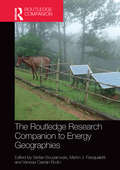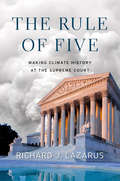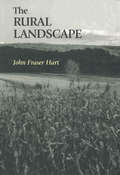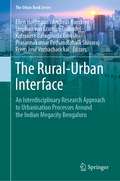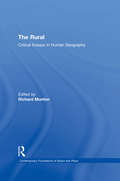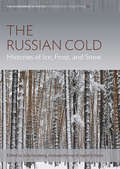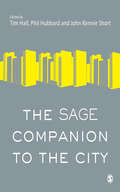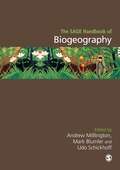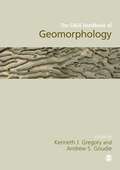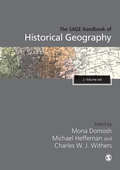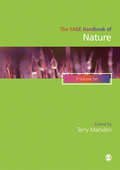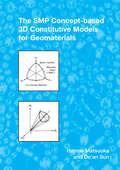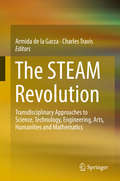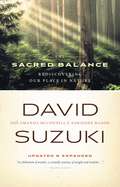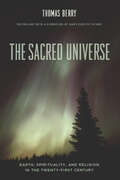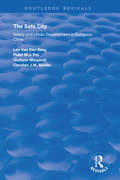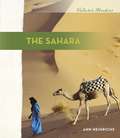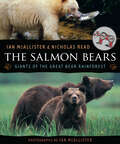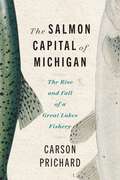- Table View
- List View
The Routledge Research Companion to Energy Geographies
by Stefan BouzarovskiEnergy has become a central concern of many strands of geographical inquiry, from global climate change to the effects of energy decisions on our lives. However, many aspects of the ‘black box’ of relationships at the energy-society interface remain unopened, especially in terms of the spatial underpinnings of energy production and consumption within nations, cities and regions. Debates focusing on the location and nature of energy flows frequently fail to consider the multiple geographical networks that illustrate and explain the distribution of fuels and services around the world. Providing an integrated perspective on the complex interdependencies between energy and geography, The Routledge Research Companion to Energy Geographies offers a timely conceptual framework to study the multiple facets of energy geography, including security, space and place, planning, environmental science, economics and political science. Illustrating how a geographic approach towards energy can aid decision-making pathways in the domains of social justice and environment, this book provides insights that will help move the international community toward greater cooperation, stability, and sustainability.
The Rule of Five: Making Climate History at the Supreme Court
by Richard J. LazarusA renowned Supreme Court advocate tells the inside story of Massachusetts v. EPA, the landmark case that made it possible for the EPA to regulate greenhouse gasses—from the Bush administration’s fierce opposition, to the internecine conflicts among the petitioners, to the razor-thin 5–4 victory.
The Rural Landscape
by John Fraser HartFrom the acclaimed landscape historian and geographer, a comprehensive handbook to understanding the elements that make up the rural landscape.Selected by Choice Magazine as an Outstanding Academic TitleIn this book, John Fraser Hart offers a comprehensive handbook to understanding the elements that make up the rural landscape—those regions that lie at or beyond the fringes of modern metropolitan life. Though the last two centuries have seen an inversion in the portion of people living on farms to those in cities, the land still beckons, whether traversed in a car or train, scanned from far above, or as the locus of our food supply or leisure. The Rural Landscape provides a deceptively simple method for approaching the often complex and variegated shape of the land. Hart divides it into its mineral, vegetable, and animal components and shows how each are interdependent, using examples from across Europe and America. Looking at the land forms of southern England, for instance, he comments on the use of hedgerows to divide fields, the mineral or geomorphological features of the land determining where hedgerows will grow in service of the human animal's needs. Hart reveals the impact on the land of human culture and the basic imperative of making a living as well as the evolution of technical skills toward that end (as seen in the advance of barbed wire as a function of modern transportation).Hart describes with equal clarity the erosion of land to form river basins and the workings of a coal mine. He charts shifting patterns of crop rotation, from the medieval rota of food (wheat or rye), feed (barley or oats), and fallow (to restore the land) to modern two-crop cycle of corn and soybeans, made possible by fertilizers and pesticides. He comments on traditions of land division (it is almost impossible to find a straight line on a map of Europe) and inventories a variety of farm structures (from hop yards and oast houses to the use of dikes for irrigation). He identifies the relict features of the landscape—from low earthen terraces once used in the southern United States to prevent erosion to old bank buildings that have become taverns and barns turned into human homes. Carrying the story of the rural landscape into our frantic era, he describes the "bow wave"where city life meets rural agriculture and plots the effect of recreation and its structures on the look of the land.
The Rural-Urban Interface: An Interdisciplinary Research Approach to Urbanisation Processes Around the Indian Megacity Bengaluru (The Urban Book Series)
by Stephan von Cramon-Taubadel Ellen Hoffmann Andreas Buerkert Kotrakere Basegowda Umesh Prasannakumar Pethandlahalli Shivaraj Prem José VazhacharickalBengaluru is one of the fastest growing megacities in India. As such, it provides an in-situ laboratory for studying rural-urban transitions. While urbanization is most evident in the changing landscape with increasing built-up areas, it comes along with changes in ecosystem functions, new economic opportunities, changes in social organization and individual attitudes and behavior. All of these processes are interlinked and mutually depend on each other. This book attempts to integrate studies from a wide scope of disciplinary perspectives and at different spatial scales under the framework of complex social-ecological systems.Agriculture is the prime example of a system in which humans interact with their biophysical environment, and the production systems in the rural-urban interface are profoundly affected by urbanisation. Intensification and diversification of agriculture are immediate responses to urban pressures and demands, and are linked as much to resource (over-)use as to commercialisation. Yet, little is known about the spatial patterns of agricultural transformation in areas of urban sprawl.The focus of the contributions here is explicitly on the interface, in-between the rural and urban systems. It thus differs from the urban-centered perspective of city planners as well as from the rural predominance in most of the agricultural research. In the present volume this focus is implemented by analysing samples along a spatial gradient representing different stages of urbanization. Ongoing time series analyses and a panel study will complement the spatial approach by a temporal dimension.
The Rural: Critical Essays in Human Geography (Contemporary Foundations of Space and Place #Vol. 1)
by Richard MuntonThe rural has long been regarded as an important site of geographical inquiry even if our understanding of it has not always been treated as conceptually different from the urban. That said, rural research has pursued a number of distinct empirical agendas ranging from the operation and impacts of agribusiness, to local resistance to global food supply chains, to differing representations of the rural. In doing so, rural geographers have critically examined the relevance and significance of ideas drawn from numerous traditions including political economy, ecological modernization and cultural theory, amending them as appropriate, in their search to understand the nature and trajectory of rural areas. Up until the 1980s, attention remained largely focused upon agriculture as the primary land-use but increasingly new forms of rural consumption - housing, recreation, nature conservation - have taken centre stage as the primacy of local agricultures has been undermined by reduced state protection and 'new' rural populations which have migrated out from the city. More recently, research has been dominated by the 'cultural turn' with particular emphases upon society-nature relations, interpretations of landscape, marginalised others, and analyses of the relations between representation and practice. In the last decade, a more holistic view of the rural, bringing together different aspects of the two previous themes, has emerged through more politically-oriented studies of rural governance concerned with the functioning of interest groups, participation, protest and the allocation and management of resources. The volume is thus structured into three sections concerned with agriculture and food, the rural, and rural governance. The great majority of the selected papers combine both empirical material - often highly informative case studies - and important conceptual arguments about change in the rural condition that can be linked to ideas being employed elsewhere in Geography and the Social Sciences more generally. These critical reflections have been drawn very largely from research conducted in advanced economies which at least provide some commonality of experience allowing the transfer of ideas between what otherwise might be seen as very differing geographical contexts.
The Russian Cold: Histories of Ice, Frost, and Snow (Environment in History: International Perspectives #22)
by Ingrid Schierle Julia Herzberg, Andreas RennerCold has long been a fixture of Russian identity both within and beyond the borders of Russia and the Soviet Union, even as the ongoing effects of climate change complicate its meaning and cultural salience. The Russian Cold assembles fascinating new contributions from a variety of scholarly traditions, offering new perspectives on how to understand this mainstay of Russian culture and history. In chapters encompassing such diverse topics as polar exploration, the Eastern Front in World War II, and the iconography of hockey, it explores the multiplicity and ambiguity of “cold” in the Russian context and demonstrates the value of environmental-historical research for enriching national and imperial histories.
The Russian Cold: Histories of Ice, Frost, and Snow (Environment in History: International Perspectives #22)
by Julia Herzberg, Andreas Renner, and Ingrid SchierleCold has long been a fixture of Russian identity both within and beyond the borders of Russia and the Soviet Union, even as the ongoing effects of climate change complicate its meaning and cultural salience. The Russian Cold assembles fascinating new contributions from a variety of scholarly traditions, offering new perspectives on how to understand this mainstay of Russian culture and history. In chapters encompassing such diverse topics as polar exploration, the Eastern Front in World War II, and the iconography of hockey, it explores the multiplicity and ambiguity of “cold” in the Russian context and demonstrates the value of environmental-historical research for enriching national and imperial histories.
The SAGE Companion to the City
by Phil Hubbard Timothy Hall John Rennie Short'This book pulls together an exceptional range of literature in addressing the complexity of contemporary patterns and processes of urbanization. It offers a rich array of concepts and theories and is studded with fascinating examples that illustrate the changing nature of cities and urban life' - Paul Knox, University Distinguished Professer, Virginia Tech University, USA 'The SAGE Companion to the City is a tour-de-force of contemporary urban studies. At once a stocktake, showcase and springboard for scholarly approaches to cities and city life, the editors have assembled a cohesive and convincing set of lucid, insightful and critical essays of great quality. Eschewing grand theory and deadening encyclopediasm, the contributors refresh both longstanding concerns and explore new themes in ways both brilliantly accessible to newcomers and satisfying to the cognoscenti' - Robert Freestone, University of New South Wales, Australia Organized in four sections The SAGE Companion to the City provides a systematic A-Z to understanding the city that explains the interrelations between society, culture and economy. Each chapter is illustrated with key extracts from the literature: " Part One: Histories: explains: power; religion; science and technology; modernity; the landscape of the city. " Part Two: Economies and Inequalities: explains: work and leisure; globalisation; innovation and the economy; and the role of the state "Part Three: Communities: explains: migration and settlement; segregation and division; civility; house and home; housing and homelessness. " Part Four: Order and Disorder: explains: politics and policy; planning and conflict; law and order; surveillance and terror. An accessible guide to all areas of urban studies; the text offers both a contemporary cutting edge reflection and measured historical and geographical reflection on urban studies. It will be essential reading for students of any discipline interested in the city as an object of study.
The SAGE Handbook of Biogeography
by Professor Andrew C Millington Mark Blumler Udo Schickhoff"A superb resource for understanding the diversity of the modern discipline of biogeography, and its history and future, especially within geography departments. I expect to refer to it often." - Professor Sally Horn, University of Tennessee "As you browse through this fine book you will be struck by the diverse topics that biogeographers investigate and the many research methods they use.... Biogeography is interdisciplinary, and a commonly-voiced concern is that one biogeographer may not readily understand another's research findings. A handbook like this is important for synthesising, situating, explaining and evaluating a large literature, and pointing the reader to informative publications." - Geographical Research "A valuable contribution in both a research and teaching context. If you are biologically trained, it provides an extensive look into the geographical tradition of biogeography, covering some topics that may be less familiar to those with an evolution/ecology background. Alternatively, if you are a geography student, researcher, or lecturer, it will provide a useful reference and will be invaluable to the non-biogeographer who suddenly has the teaching of an introductory biogeography course thrust upon them." - Adam C. Algar, Frontiers of Biogeography The SAGE Handbook of Biogeography is a manual for scoping the past, present and future of biogeography that enable readers to consider, where relevant, how similar biogeographical issues are tackled by researchers in different 'schools'. In line with the concept of all SAGE Handbooks, this is a retrospective and prospective overview of biogeography that will: Consider the main areas of biogeography researched by geographers Detail a global perspective by incorporating the work of different schools of biogeographers Ecplore the divergent evolution of biogeography as a discipline and consider how this diversity can be harnessed Examine the interdisciplinary debates that biogeographers are contributing to within geography and the biological sciences. Aimed at an international audience of research students, academics, researchers and practitioners in biogeography, the text will attract interest from environmental scientists, ecologists, biologists and geographers alike.
The SAGE Handbook of Environmental Change: Volume 1: Approaches, Evidences and Causes Volume 2: Human Impacts and Responses
by John A MatthewsThe SAGE Handbook of Environmental Change is an extensive survey of the interdisciplinary science of environmental change, including recent debates on climate change and the full range of other natural and anthropogenic changes affecting the Earth-ocean-atmosphere system in the past, present and future. It examines the historic importance, present status and future prospects of the field over two volumes. With more than 40 chapters, the books situate the defining characteristics and key paradigms within a state-of-the-art review of the field, including its changing nature and diversity of approaches, evidence base, key theoretical arguments, resonances with other disciplines and relationships between theory, research and practice. Opening with a detailed, contextualizing essay by the editors, the work is arranged into six parts: Part One: Approaches to Understanding Environmental Change Part Two: Evidence of Environmental Change and the Geo-ecological Response Part Three: Causes, Mechanisms and Dynamics of Environmental Change Part Four: Key Issues of Human-induced Environmental Changes and Their Impacts Part Five: Patterns, Processes and Impacts of Environmental Change at the Regional Scale Part Six: Responses of People to Environmental Change and Implications for Society Global in its coverage, scientific and theoretical in its approach, the books bring together an international set of respected editors and contributors to provide an exciting, timely addition to the literature on climate change. With the subjects' interdisciplinary framework, this book will appeal to academics, researchers, postgraduates and practitioners in a variety of disciplines including, geography, geology, ecology, environmental science, archaeology, anthropology, politics and sociology.
The SAGE Handbook of Geomorphology
by Kenneth J. Gregory Andrew S GoudieGeomorphology is the study of the Earth's diverse physical land-surface features and the dynamic processes that shape these features. Examining natural and anthropogenic processes, The SAGE Handbook of Geomorphology is a comprehensive exposition of the fundamentals of geomorphology that examines form, process, and applications of the discipline. Organized into five substantive sections, the Handbook is an overview of: * Foundations and Relevance: including the nature and scope of geomorphology; the origins and development of geomorphology; the role and character of theory in geomorphology; geomorphology and environmental management; and geomorphology and society * Techniques and Approaches: including observations and experiments; geomorphological mapping; the significance of models; process and form; dating surfaces and sediment; remote sensing in geomorphology; GIS in geomorphology; biogeomorphology; human activity * Process and Environment: including the evolution of regolith; weathering; fluids, flows and fluxes; sediment transport and deposition; hill slopes; riverine environments; glacial geomorphology; periglacial environments; coastal environments; aeolian environments; tropical environments; karst and karst processes * Environmental Change: including landscape evolution and tectonics; interpreting quaternary environments; environmental change; disturbance and responses to geomorphic systems * Conclusion: including challenges and perspectives; and a concluding review The Handbook has contributions from 48 international authors and was initially organized by the International Association of Geomorphologists. This will be a much-used and much-cited reference for researchers in Geomorphology, Physical Geography and the Environmental Sciences.
The SAGE Handbook of Historical Geography
by Mona Domosh Charles W. J. Withers Michael HeffernanHistorical geography is an active, theoretically-informed and vibrant field of scholarly work within modern geography, with strong and constantly evolving connections with disciplines across the humanities and social sciences. Across two volumes, The SAGE Handbook of Historical Geography provides you with an an international and cross-disciplinary overview of the field, presenting chapters that examine the history, present condition and future potential of the discipline in relation to recent developments and research.
The SAGE Handbook of Historical Geography
by Mona Domosh Charles W. J. Withers Michael HeffernanHistorical geography is an active, theoretically-informed and vibrant field of scholarly work within modern geography, with strong and constantly evolving connections with disciplines across the humanities and social sciences. Across two volumes, The SAGE Handbook of Historical Geography provides you with an an international and cross-disciplinary overview of the field, presenting chapters that examine the history, present condition and future potential of the discipline in relation to recent developments and research.
The SAGE Handbook of Nature
by Professor Terry MarsdenThe SAGE Handbook of Nature offers an ambitious retrospective and prospective overview of the field that aims to position Nature, the environment and natural processes, at the heart of interdisciplinary social sciences. The three volumes are divided into the following parts: INTRODUCTION TO THE HANDBOOK NATURAL AND SOCIO-NATURAL VULNERABILITIES: INTERWEAVING THE NATURAL & SOCIAL SCIENCES SPACING NATURES: SUSTAINABLE PLACE MAKING AND ADAPTATION COUPLED AND (DE-COUPLED) SOCIO-ECOLOGICAL SYSTEMS RISK AND THE ENVIRONMENT: SOCIAL THEORIES, PUBLIC UNDERSTANDINGS, & THE SCIENCE-POLICY INTERFACE HUNGRY AND THIRSTY CITIES AND THEIR REGIONS CRITICAL CONSUMERISM AND ITS MANUFACTURED NATURES GENDERED NATURES AND ECO-FEMINISM REPRODUCTIVE NATURES: PLANTS, ANIMALS AND PEOPLE NATURE, CLASS AND SOCIAL INEQUALITY BIO-SENSITIVITY & THE ECOLOGIES OF HEALTH THE RESOURCE NEXUS AND ITS RELEVANCE SUSTAINABLE URBAN COMMUNITIES RURAL NATURES AND THEIR CO-PRODUCTION This handbook is a key critical research resource for researchers and practitioners across the social sciences and their contributions to related disciplines associated with the fast developing interdisciplinary field of sustainability science.
The SAGE Handbook of Nature
by Professor Terry MarsdenThe SAGE Handbook of Nature offers an ambitious retrospective and prospective overview of the field that aims to position Nature, the environment and natural processes, at the heart of interdisciplinary social sciences. The three volumes are divided into the following parts: INTRODUCTION TO THE HANDBOOK NATURAL AND SOCIO-NATURAL VULNERABILITIES: INTERWEAVING THE NATURAL & SOCIAL SCIENCES SPACING NATURES: SUSTAINABLE PLACE MAKING AND ADAPTATION COUPLED AND (DE-COUPLED) SOCIO-ECOLOGICAL SYSTEMS RISK AND THE ENVIRONMENT: SOCIAL THEORIES, PUBLIC UNDERSTANDINGS, & THE SCIENCE-POLICY INTERFACE HUNGRY AND THIRSTY CITIES AND THEIR REGIONS CRITICAL CONSUMERISM AND ITS MANUFACTURED NATURES GENDERED NATURES AND ECO-FEMINISM REPRODUCTIVE NATURES: PLANTS, ANIMALS AND PEOPLE NATURE, CLASS AND SOCIAL INEQUALITY BIO-SENSITIVITY & THE ECOLOGIES OF HEALTH THE RESOURCE NEXUS AND ITS RELEVANCE SUSTAINABLE URBAN COMMUNITIES RURAL NATURES AND THEIR CO-PRODUCTION This handbook is a key critical research resource for researchers and practitioners across the social sciences and their contributions to related disciplines associated with the fast developing interdisciplinary field of sustainability science.
The SMP Concept-Based 3D Constitutive Models for Geomaterials
by Hajime MatsuokaThe Cam-Clay model is a fundamental constitutive model in soil mechanics, but is only suitable for normally consolidated clay under triaxial compression stress states. This book introduces the SMP criterion, its integration with the well-known Cam-clay model, and its application to the general eleastoplastic constitutive models for geomaterials like clay, sand and unsaturated soil.
The STEAM Revolution: Transdisciplinary Approaches to Science, Technology, Engineering, Arts, Humanities and Mathematics
by Charles Travis Armida de la GarzaThis volume is dedicated to collaborative research across STEM disciplines, the arts and humanities. It includes six sections, framed from a global perspective and exhibits contributions from key experts in the field, emerging scholarly voices, and STEAM practitioners. The added value of STEAM projects in research is highlighted in the first section of this book. Ranging from the spatial, medical and environmental humanities to heritage science, this section discusses the course and paths STEAM projects may evolve to in the near future. The second section features reflective essays by scientists and artists on the development of their research, their professional growth and personal learning experiences that the art/science collaborations have afforded their work and careers. Sections III and IV provides practical guidance and advice on facilitating STEAM teams and describe successful collaborative projects. By presenting the objectives and outcomes of relevant research, the chapters in these sections discuss the various steps taken by different teams to achieve project fruition. Paying particular attention to barriers inhibiting STEAM collaboration, these sections also explore the ways in which research teams were able to work effectively. The fifth section presents a review of policy issues and the potential impacts of STEAM research for administrators, funders and policy makers. In its pursuit for balance and inclusion, the volume concludes with a critical reflection on STEAM that argues a different perspective and will prove food for thought to readers.
The Sacred Balance
by David Suzuki Adrienne Mason Amanda McconnellIn this extensively revised and enlarged edition of his best-selling book, David Suzuki reflects on the increasingly radical changes in nature and science - from global warming to the science behind mother/baby interactions - and examines what they mean for humankind's place in the world. The book begins by presenting the concept of people as creatures of the Earth who depend on its gifts of air, water, soil, and sun energy. The author explains how people are genetically programmed to crave the company of other species, and how people suffer enormously when they fail to live in harmony with them. Suzuki analyzes those deep spiritual needs, rooted in nature, that are a crucial component of a loving world. Drawing on his own experiences and those of others who have put their beliefs into action, The Sacred Balance is a powerful, passionate book with concrete suggestions for creating an ecologically sustainable, satisfying, and fair future by rediscovering and addressing humanity's basic needs.
The Sacred Universe: Earth, Spirituality, and Religion in the Twenty-First Century
by Thomas Berry&“Dedicated readers of ecology, theology, or religious philosophy will want to savor each one [of these essays]&” from the renowned environmental thinker (Library Journal). A leading scholar, cultural historian, and Catholic priest who spent more than fifty years writing about our engagement with the Earth, Thomas Berry possessed prophetic insight into the rampant destruction of ecosystems and the extinction of species. In this book he makes a persuasive case for an interreligious dialogue that can better confront the environmental problems of the twenty-first century. These erudite and keenly sympathetic essays represent Berry&’s best work, covering such issues as human beings&’ modern alienation from nature and the possibilities of future, regenerative forms of religious experience. Asking that we create a new story of the universe and the emergence of the Earth within it, Berry resituates the human spirit within a sacred totality. &“This book addresses how the history and diversity of world religions offer ways to engage with Earth; how it is necessary to connect with a spirituality that is Earth derived; how science can be in conversation with the religious sensibilities of wonder and awe; and how our relationship to the natural world is crucial to our spirituality. In the earliest essays, Berry sounds most optimistic and urges readers to reconcile modern impulses and technology with religious traditions.&”—Publishers Weekly &“Thomas Berry demonstrates in these papers the qualities he calls for: humanist vision and imagination.&”—Resurgence
The Safe City: Safety and Urban Development in European Cities (Routledge Revivals)
by Peter M.J. PolFirst published in 2006, as numerous local authorities of European cities invest in the attractiveness of their urban areas in the hope of attracting new inhabitants and economic activities, safety has become a topical subject. Perceived safety is a major factor in a city's attractiveness and fear of crime can have a large impact on location decisions, with ensuing economic consequences. This book examines the role of security in urban development and its local policy implications. Comparing eleven European cities, it analyses how actual and perceived security is evolving, and what the economic, social and spatial consequences are of a changing perceived security. While crime has decreased in eight of the eleven cities, fear of crime has increased in all of them. This book discusses the factors influencing this fear, including the role of the media, the quality and maintenance of the built environment, socio-economic inequality and terrorism.
The Sahara Desert
by Ann HeinrichsProvides comprehensive information on the geography, history, wildlife, peoples, and environmental issues of the Sahara Desert.
The Sahara: World's Largest Desert
by Jil FineThis book goes in depth into the Sahara Desert. It explains it's location, climate, land, and the people that live there.
The Salmon Bears: Giants of the Great Bear Rainforest
by Nicholas ReadExtensively illustrated with Ian McAllister's magnificent photographs, The Salmon Bears explores the delicate balance that exists between the grizzly, black and spirit bears and their natural environment, the last great wilderness along the central coast of British Columbia. Key to this relationship are the salmon that are born in the rivers each spring, who then go out to sea as juveniles and return as adults to spawn and die, completing a cycle of life that ensures the survival of not only their own species but also virtually every other plant and animal in the rainforest. In clear language suitable for young readers, the authors describe the day-to-day activities that define the lives of these bears through the four seasons. But this is also very much the story of the Great Bear Rainforest—a vast tract of land that stretches from the northern tip of Vancouver Island to the Alaska border and contains some of the largest stands of old-growth forest left on the West Coast. The Salmon Bears focuses on the interconnectedness of all life in the rainforest and makes a strong case for the importance of protecting this vital ecological resource.
The Salmon Capital of Michigan: The Rise and Fall of a Great Lakes Fishery (Great Lakes Books Series)
by Carson PrichardWeaving together the stories and voices of residents, anglers, community leaders, and environmental workers and researchers, this ethnographic account details the lives and livelihoods impacted by a once-unrivaled Michigan salmon fishery. From the introduction of Chinook salmon to the Great Lakes in the late 1960s, a thriving recreational fishery industry arose in Northern Michigan, attracting thousands of anglers to small towns like Rogers City each week at its peak. By the early 2000s, a crisis loomed beneath the surface of Lake Huron as the population of a prey fish species called alewife unexpectedly collapsed, depleting the salmon’s main source of food. By 2007, the salmon population had collapsed too, leaving local fisheries and their respective communities lacking a key commodity and a bid on fishery tourism. Author, angler, and ecologist Carson Prichard artfully incorporates fisheries science and local news media into an oral history that is entertaining, rich, and genuine. Complementing an ecological understanding of events, this narrative details the significance of the fishery and its loss as experienced by the townspeople whose lives it touched.
